Bedlasky
International Hazard
    
Posts: 1219
Registered: 15-4-2019
Location: Period 5, group 6
Member Is Offline
Mood: Volatile
|
|
Selenium polycations
Hi.
I tried to make polycations of selenium in 96% H2SO4. Procedure is simple.
Add small amount of selenium in to the test tube and add H2SO4. Heat the mixture carefully above a flame. After some time Se start slowly dissolving
to form green solution containing Se8(2+) cations.
I made few inovations to this experiment based on this paper:
https://macsphere.mcmaster.ca/bitstream/11375/18737/1/Kapoor...
I added some Na2SeO3 to the green solution. Not much happend and I wonder why this reaction refuse to work. So I try to decant solution in to the
clean test tube, leaving undissolved Se behind. Then I added Na2SeO3 again. Yellow solution containing Se4(2+) was formed. Se(IV) is ideal oxidant,
because it won't overoxidize yellow solution.
Oxidation of elemental selenium by selenite works well even at room temperature or in hot water bath, no strong heating needed.
I tried reduction of Na2SeO3 by hydrazine sulfate, but reduction was incomplete because hydrazine probably reacted with conc. H2SO4, but at least
partiall reduction to Se4(2+) was succsesful. Next time I will try different reducing agent.
I also plan experiments with Se and other oxidizing agents.
Both polycations hydrolyze in water to red selenium and SeO2.
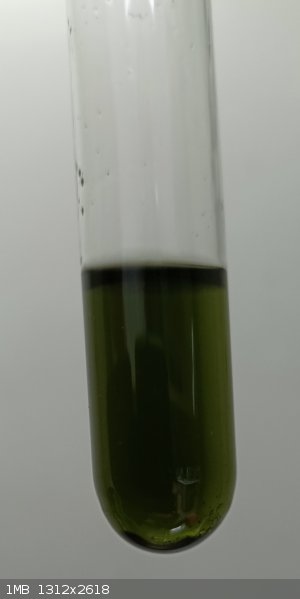 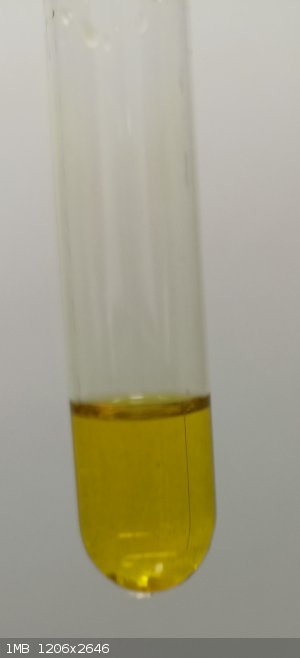 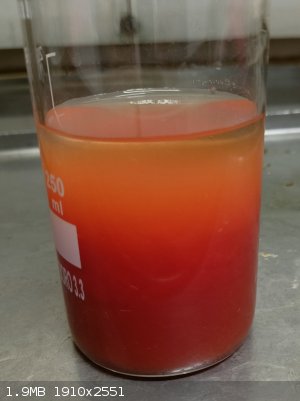
|
|
|
Fery
National Hazard
   
Posts: 990
Registered: 27-8-2019
Location: Czechoslovakia
Member Is Offline
|
|
Bedlasky well done! Beautiful colors!
|
|
|
teodor
National Hazard
   
Posts: 872
Registered: 28-6-2019
Location: Heerenveen
Member Is Offline
|
|
Thank you for the article. I found some information about behaviour of CrO3 in concentrated sulfuric acid which could explain some peculiarities I
have observed.
As for selenium chemistry - it is interesting. I have some interest in SeOCl2 but its high toxicity stopped me to explore the world of this element
yet.
|
|
|
woelen
Super Administrator
        
Posts: 7977
Registered: 20-8-2005
Location: Netherlands
Member Is Offline
Mood: interested
|
|
I have done similar experiments, with Te, Se and S. This indeed is very interesting chemistry: https://woelen.homescience.net/science/chem/exps/SSeTe_H2SO4...
-------------------------------------------------------------------------------
The next link can be used to view a textual description of an experiment with Te, Se and S in chlorosulfonic acid: https://woelen.homescience.net/expviewer
On the webpage, click "experiment by ID" in the blue bar at the top of the page. Next, in the text field, give the number 652. Then you can read about
the experiment.
|
|
|
Bedlasky
International Hazard
    
Posts: 1219
Registered: 15-4-2019
Location: Period 5, group 6
Member Is Offline
Mood: Volatile
|
|
Thanks, Fery!
Quote: Originally posted by teodor  | Thank you for the article. I found some information about behaviour of CrO3 in concentrated sulfuric acid which could explain some peculiarities I
have observed.
As for selenium chemistry - it is interesting. I have some interest in SeOCl2 but its high toxicity stopped me to explore the world of this element
yet. |
Solutions of SeOCl2 in HCl:
https://sci-hub.se/https://pubs.acs.org/doi/pdf/10.1021/ic50...
You can find this usefull.
I was inspired by your article when doing this experiment. Nice work as always Woelen!
[Edited on 12-7-2023 by Bedlasky]
|
|
|
Bedlasky
International Hazard
    
Posts: 1219
Registered: 15-4-2019
Location: Period 5, group 6
Member Is Offline
Mood: Volatile
|
|
Here is another set of experiments.
Dissolve small amount of NaNO3, K2S2O8 and NaClO3 in 96% sulfuric acid (in the case of chlorate it's important to add chlorate in to the acid, not the
other way around). Chlorate form red-orange solution containing ClO2+ ions, other solutions are colourless. Add some elemental selenium in to these
solutions. Heating in hot water bath speed things up. Reactions with nitrate and chlorate are rapid - in the case of nitrate you can see gradual
change from colourless to green to yellow solution. In the case of chlorate you can see change from red-orange to yellow. Further addition of oxidant
doesn't change the colour, it seems that Se4(2+) is final oxidation product, but oxidation in reality proceed further to Se(IV) (yellow colour is from
NO2/ClO2). If you add these solutions in to the water, little to no red Se precipitates out. Oxidation by persulfate is slugish, you can observe green
colour relatively quickly, but change from green to yellow is painfully slow.
I tested if nitrite and sulfite can reduce selenite in 96% H2SO4 in to coloured polycations, but they didn't react (which is surprising with sulfite,
because normaly sulfite in acidified solution reduce selenite to red Se). Hydroxylamine hydrochloride react quicker with H2SO4 than with selenite, so
this didn't work also. Only think that worked is thiosulfate, which produce orange mixture of red Se and sulfur.
However, nitrite fairly quickly oxidize elemental selenium in to the green Se8(2+) and then in to yellow Se4(2+).
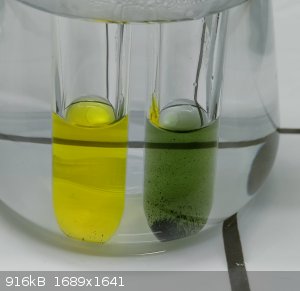
Nitrate on the left, persulfate on the righ.
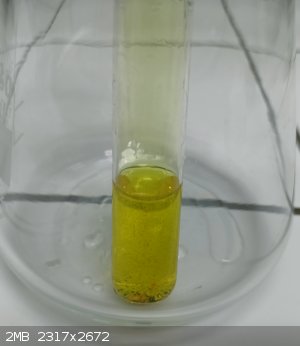
Chlorate.
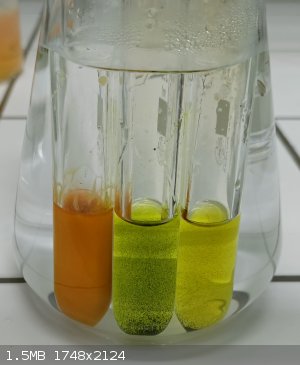
Thiosulfate on the left, on the right and in the middle nitrite.
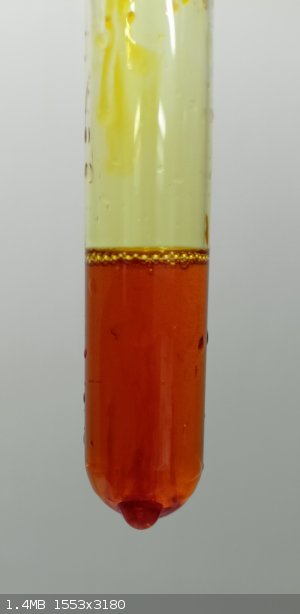
Chloryl cations in 96% H2SO4.
[Edited on 16-7-2023 by Bedlasky]
|
|
|
chornedsnorkack
National Hazard
   
Posts: 523
Registered: 16-2-2012
Member Is Offline
Mood: No Mood
|
|
Are you sure that chlorate or persulfate do not oxidize selenite to selenate?
|
|
|
Bedlasky
International Hazard
    
Posts: 1219
Registered: 15-4-2019
Location: Period 5, group 6
Member Is Offline
Mood: Volatile
|
|
It's possible, I didn't check if oxidation proceed to IV or VI oxidation state.
|
|
|
chornedsnorkack
National Hazard
   
Posts: 523
Registered: 16-2-2012
Member Is Offline
Mood: No Mood
|
|
How did you test the product for being a pure mixture, and rule out selenium sulphides? Chromatography?
|
|
|
Bedlasky
International Hazard
    
Posts: 1219
Registered: 15-4-2019
Location: Period 5, group 6
Member Is Offline
Mood: Volatile
|
|
Selenite reacts with thiosulfate to form selenopentathionate:
https://cdnsciencepub.com/doi/pdf/10.1139/v96-082
Sulfur in reaction mixture is from decomposition of thiosulfate.
Selenium disulfide is prepared by decomposition of selenosulfides in acidic solution:
https://patents.google.com/patent/CN102060277A/en
|
|
|
chornedsnorkack
National Hazard
   
Posts: 523
Registered: 16-2-2012
Member Is Offline
Mood: No Mood
|
|
It´s called SeS2 (with the given molecular mass), as is common. Which actually is an unlikely compound, at low temperatures!
|
|
|
woelen
Super Administrator
        
Posts: 7977
Registered: 20-8-2005
Location: Netherlands
Member Is Offline
Mood: interested
|
|
I have some so-called "SeS2". It is a nice orange powder, with a slight brownish hue. I do not believe it really is SeS2. Most likely it is like
sulfur (S8) in the form of rings, with some S-atoms, replaced by Se-atoms, approximately, averaged over many many molecules, one out of every three
sulfur atoms is replaced by Se-atoms.
In an experiment I did, however, I was not capable of making "SeS2" from pure Se and pure S. I took a little S, melted this until I obtained a yellow
liquid (which still is mobile) and I added a small amount of pure Se. This Se dissolves (slowly), and it makes the liquid very dark, almost black. On
cooling down, I obtained an olive-green solid. This solid only contained a tiny amount of Se, compared to S, but this smnall quantity of Se has a very
strong influence on the color of the S. In my experiment, probably no rings were broken en simply very dark Se dissolved in the sulfur, giving a very
dark solution, which also remains dark when it solidifies again.
|
|
|
chornedsnorkack
National Hazard
   
Posts: 523
Registered: 16-2-2012
Member Is Offline
Mood: No Mood
|
|
Quote: Originally posted by woelen  | | I have some so-called "SeS2". It is a nice orange powder, with a slight brownish hue. I do not believe it really is SeS2. Most likely it is like
sulfur (S8) in the form of rings, with some S-atoms, replaced by Se-atoms, approximately, averaged over many many molecules, one out of every three
sulfur atoms is replaced by Se-atoms. |
Indeed. Both S and Se alone minimize ring strain at 8-membered ring... but you cannot get SeS2 of 8 atoms. The neighbouring 8 membered compositions
would be Se2S6 (3 isomers) and Se3S5 (5 isomers). But there are some different sized molecules in S certainly.
Quote: Originally posted by woelen  |
In an experiment I did, however, I was not capable of making "SeS2" from pure Se and pure S. I took a little S, melted this until I obtained a yellow
liquid (which still is mobile) and I added a small amount of pure Se. This Se dissolves (slowly), and it makes the liquid very dark, almost black. On
cooling down, I obtained an olive-green solid. This solid only contained a tiny amount of Se, compared to S, but this smnall quantity of Se has a very
strong influence on the color of the S. In my experiment, probably no rings were broken en simply very dark Se dissolved in the sulfur, giving a very
dark solution, which also remains dark when it solidifies again. |
Well, S8 rings do break already at melting point of 120 degrees, because while S8 remains the main component of molten S, it equilibrates with S6 and
S7 admixture. And Se8 rings break well below 100 degrees because while red Se is stable at 20 degrees, in hot water (that is below 100 degrees) it
promptly converts into black Se.
Both S and red Se dissolve in carbon disulphide. Do S8 and Se8 form solid solutions when they are crystallized out of solutions of both?
|
|
|